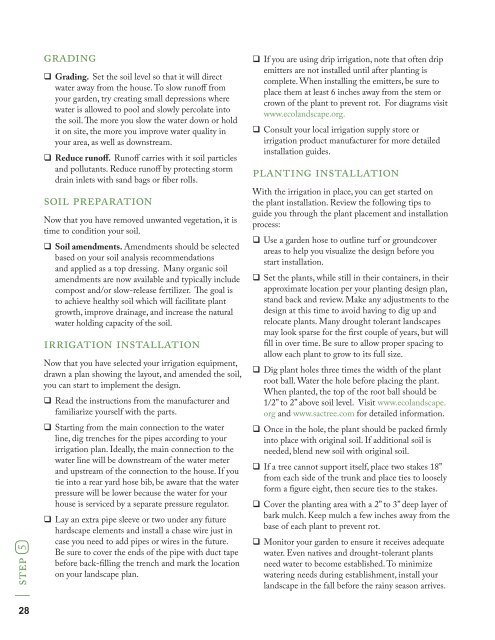A Homeowner's Guide to a WaterSmart Landscape
You also want an ePaper? Increase the reach of your titles
YUMPU automatically turns print PDFs into web optimized ePapers that Google loves.
| step 5<br />
grading<br />
<br />
Grading. Set the soil level so that it will direct<br />
water away from the house. To slow runoff from<br />
your garden, try creating small depressions where<br />
water is allowed <strong>to</strong> pool and slowly percolate in<strong>to</strong><br />
the soil. The more you slow the water down or hold<br />
it on site, the more you improve water quality in<br />
your area, as well as downstream.<br />
<br />
Reduce runoff. Runoff carries with it soil particles<br />
and pollutants. Reduce runoff by protecting s<strong>to</strong>rm<br />
drain inlets with sand bags or fiber rolls.<br />
soil preparation<br />
Now that you have removed unwanted vegetation, it is<br />
time <strong>to</strong> condition your soil.<br />
<br />
Soil amendments. Amendments should be selected<br />
based on your soil analysis recommendations<br />
and applied as a <strong>to</strong>p dressing. Many organic soil<br />
amendments are now available and typically include<br />
compost and/or slow-release fertilizer. The goal is<br />
<strong>to</strong> achieve healthy soil which will facilitate plant<br />
growth, improve drainage, and increase the natural<br />
water holding capacity of the soil.<br />
irrigation installation<br />
Now that you have selected your irrigation equipment,<br />
drawn a plan showing the layout, and amended the soil,<br />
you can start <strong>to</strong> implement the design.<br />
<br />
Read the instructions from the manufacturer and<br />
familiarize yourself with the parts.<br />
<br />
Starting from the main connection <strong>to</strong> the water<br />
line, dig trenches for the pipes according <strong>to</strong> your<br />
irrigation plan. Ideally, the main connection <strong>to</strong> the<br />
water line will be downstream of the water meter<br />
and upstream of the connection <strong>to</strong> the house. If you<br />
tie in<strong>to</strong> a rear yard hose bib, be aware that the water<br />
pressure will be lower because the water for your<br />
house is serviced by a separate pressure regula<strong>to</strong>r.<br />
<br />
Lay an extra pipe sleeve or two under any future<br />
hardscape elements and install a chase wire just in<br />
case you need <strong>to</strong> add pipes or wires in the future.<br />
Be sure <strong>to</strong> cover the ends of the pipe with duct tape<br />
before back-filling the trench and mark the location<br />
on your landscape plan.<br />
<br />
If you are using drip irrigation, note that often drip<br />
emitters are not installed until after planting is<br />
complete. When installing the emitters, be sure <strong>to</strong><br />
place them at least 6 inches away from the stem or<br />
crown of the plant <strong>to</strong> prevent rot. For diagrams visit<br />
www.ecolandscape.org.<br />
<br />
Consult your local irrigation supply s<strong>to</strong>re or<br />
irrigation product manufacturer for more detailed<br />
installation guides.<br />
planting installation<br />
With the irrigation in place, you can get started on<br />
the plant installation. Review the following tips <strong>to</strong><br />
guide you through the plant placement and installation<br />
process:<br />
<br />
Use a garden hose <strong>to</strong> outline turf or groundcover<br />
areas <strong>to</strong> help you visualize the design before you<br />
start installation.<br />
<br />
Set the plants, while still in their containers, in their<br />
approximate location per your planting design plan,<br />
stand back and review. Make any adjustments <strong>to</strong> the<br />
design at this time <strong>to</strong> avoid having <strong>to</strong> dig up and<br />
relocate plants. Many drought <strong>to</strong>lerant landscapes<br />
may look sparse for the first couple of years, but will<br />
fill in over time. Be sure <strong>to</strong> allow proper spacing <strong>to</strong><br />
allow each plant <strong>to</strong> grow <strong>to</strong> its full size.<br />
<br />
Dig plant holes three times the width of the plant<br />
root ball. Water the hole before placing the plant.<br />
When planted, the <strong>to</strong>p of the root ball should be<br />
1/2” <strong>to</strong> 2” above soil level. Visit www.ecolandscape.<br />
org and www.sactree.com for detailed information.<br />
<br />
Once in the hole, the plant should be packed firmly<br />
in<strong>to</strong> place with original soil. If additional soil is<br />
needed, blend new soil with original soil.<br />
<br />
If a tree cannot support itself, place two stakes 18”<br />
from each side of the trunk and place ties <strong>to</strong> loosely<br />
form a figure eight, then secure ties <strong>to</strong> the stakes.<br />
<br />
Cover the planting area with a 2” <strong>to</strong> 3” deep layer of<br />
bark mulch. Keep mulch a few inches away from the<br />
base of each plant <strong>to</strong> prevent rot.<br />
Moni<strong>to</strong>r your garden <strong>to</strong> ensure it receives adequate<br />
water. Even natives and drought-<strong>to</strong>lerant plants<br />
need water <strong>to</strong> become established. To minimize<br />
watering needs during establishment, install your<br />
landscape in the fall before the rainy season arrives.<br />
28



